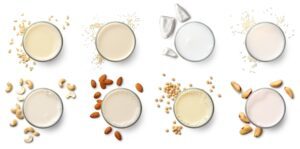
Jessica Cotton


If you want to get your gut in order, Dr Will Bulsiewicz is the expert to help you sort out fact from fiction. This is the gut-health cheat sheet...
In the fast-paced and demanding world we live in, finding moments of stillness and calm can be challenging. In an attempt to find a little peace...
Ramp up your family burger night with crumbed oyster mushrooms and a super tasty, creamy sauce.
These easy seitan kebabs are the perfect crowd pleaser at any summer barbecue feast. The active steps take less than an hour, but be sure to...
Bursting with goodness, this nutritious and ultra-satisfying green curry combines tofu, green split peas, luscious fresh greens and the...
Somewhere between a smoothie and ice cream, this pumpkin pie nice cream tastes divine and makes for a refreshing, nutritious breakfast, snack, or...
Think mashed potatoes, but elevated. Our take on the traditional side dish features vegan sour cream, garlic, and a secret weapon that might...
A treat for the eyes as well as the tastebuds, these doughnuts are spiced with aromatic ginger and topped with a vanilla-scented maple glaze....
Comfort food the whole family will love, this veggie-loaded macaroni ‘cheese’ is simply divine and super healthy too!
Spraying sheets and pillows with calming scents can be a wonderful aid to slumber
The next time you go for a walk, discover the wonder of the everyday world around you
A skincare routine can be a way to nourish yourself inside and out
When the clouds converge, practise gratitude for the smallest of glimmers, and learn to dance in the rain.
We’re all going nuts for plant-based milks, but when it comes to health and environment, which option has the most compelling credentials?
The way we consume milk has changed dramatically in recent years. Gone are the times when ordering a soy latte would elicit raised eyebrows and a wisecrack or two. Today, plant milks made with ingredients such as almonds, coconuts, oats, rice, and soy are largely considered a mainstream choice. So what’s changed? And how do plant milks stack up against dairy when it comes to our health and the environment? Here’s everything you need to know before placing your next coffee order.
Plant milks have been steadily growing in popularity and, according to market research agency IBISWorld, now account for at least seven percent of all milk consumed in Australia. Demand is led by the ‘big five’ – soy, almond, oat, coconut, and rice milks. Soy currently accounts for almost half of Australia’s plant milk market, although almond is forecast to take the lead in the near future.
As our tastes change, you’d be forgiven for thinking that plant milks represent just another fad in food and beverages. The truth is that plant-derived ‘milks’ have been used by humans for centuries, if not millennia. Recipes involving non-dairy milk can be traced throughout history across Asia, Africa, Europe, and the Middle East – and remain part of global culinary traditions today.
Reports by IBISWorld show the consumption of cow’s milk has fallen over the past five years, and nobody is monitoring the reasons for this decline more closely than the dairy industry itself. According to Dairy Australia, consumers perceive plant milks as ‘cleaner and greener’. At the same time, an occasional paper published by the Australian Farm Institute pointed out that consumers are becoming increasingly aware of the environmental costs of dairy production.
But the reason for change at a consumer level could be even more straightforward – it’s simply never been easier for people to find the non-dairy milk they prefer. Increased product innovation and competition means that you can now access a wide variety of plant milks at your local grocery store. Along with the big five, milk made from cashews, hazelnuts, hemp, and macadamias are all readily available to taste and enjoy.

Image: baibaz on Shutterstock
So how do plant milks stack up health-wise? How do they compare to dairy milk? And how does fortification (the process of adding micronutrients to milk) play a role?
Soy milk – Primarily made with whole soybeans, soy milk can be considered a good source of protein. In fact, most soy milks contain all nine essential amino acids necessary for the human body. In addition to protein content that’s equivalent to cow’s milk, soy milk generally contains less sugar and is free from lactose, an allergen commonly found in dairy. Today, many soy milks are also fortified with vitamin A, vitamin B12, vitamin D, calcium, and other nutrients. Soy milk has been a long-favoured dairy alternative for good reason!
Almond milk – This milk tends to be a lower-calorie option than other milks, provided it’s unsweetened. Also, a glass of almond milk is usually lower in saturated fat than full cream cow’s milk. For added nutritional benefits, it’s worthwhile choosing almond milk that’s enriched with calcium, protein, and vitamins.
Oat milk – Another milk that is typically lower in saturated fat than cow’s milk. Notably, oat milk contains soluble fibre known as beta-glucan, which studies suggest can help to reduce high cholesterol and support good heart health. Look for oat milk that’s fortified with calcium, vitamins, and minerals. Some oat milk brands further enrich their products with protein derived from peas and other plant-based ingredients.
Coconut milk – While higher in saturated fat than most plant milks, coconut milk normally contains less fat than dairy. Coconuts are botanically distinct from most tree nuts. As a result, coconut milk is usually safe to drink even if you have a nut allergy. Shop for coconut milk that’s fortified with calcium, vitamins, and minerals, and has no added sugars.
Rice milk – This is the least allergenic choice in milk, and is suitable for people who cannot consume lactose, soy, or nuts. If you like something a little sweet, it may be useful to know that rice milk contains naturally occurring sugars. Rice milk is also frequently fortified with calcium and vitamin D.
Cow’s milk – This brings us to full cream dairy, which tends to have a higher saturated fat content than any of the plant milks listed above. While cow’s milk is naturally high in protein and calcium – as you’d expect from mothers’ milk lactated to nurture a calf into adulthood – you’ll find that dairy milk is also often fortified with vitamin D.
As Leah Dowling, a lecturer in dietetics at Swinburne University and Accredited Practising Dietitian, emphasised in an article for The Conversation, “Although dairy milk has a high nutritional value, there is no reason why people need to drink it if they choose not to. All of the nutrients in milk can be obtained elsewhere in the diet.”
The fact is that cow’s milk and other dairy products have been linked to Alzheimer’s, heart disease, type 2 diabetes, and other serious health concerns. Why take on the risks when fortification makes it possible to enjoy the nutritional benefits of milk on a plant-based diet?
In recent years, conscious consumers have become concerned about the sustainability of certain crops, such as almonds and coconuts. While no discussion about milk would be complete without considering these environmental impacts, it’s important to highlight that all plant milks have proven better for the planet than dairy.
In 2018, a landmark study revealed that dairy milk requires nine times more land to produce than any plant-based alternative. Researchers from the University of Oxford also went on to demonstrate that dairy milk production involves three times more greenhouse gas emissions. They concluded that eschewing meat and dairy in favour of a vegan diet is the “single biggest way” that any of us can reduce our environmental impact.
If you want to make a commitment to lowering your carbon footprint one step further, you can opt for soy milk that is locally produced. You may also wish to try milk made from ‘niche’ crops like hemp, which is typically grown in smaller, more sustainable quantities.
Let’s end as we started – with a word on coffee. If you’re brewing at home, warming your chosen plant milk before adding coffee will help ensure your morning caffeine hit stays smooth and curdle free. Meantime, cafe goers will be pleased to know that barista-blend plant milks are becoming increasingly common in supermarkets. Barista blends are specially formulated to offer rich, frothy coffees without the dairy milk.
With a vast array of plant milks now readily available to taste and enjoy, there’s really never been a better time to switch up your routine and try something new. Your body, the planet, and our animal friends will thank you for it. Good luck – catch you latte!
Lead image: Austin Wilcox on Unsplash
If you want to get your gut in order, Dr Will Bulsiewicz is the expert to help you sort out fact from fiction. This is the gut-health cheat sheet...
In the fast-paced and demanding world we live in, finding moments of stillness and calm can be challenging. In an attempt to find a little peace...
Spraying sheets and pillows with calming scents can be a wonderful aid to slumber
The next time you go for a walk, discover the wonder of the everyday world around you
A skincare routine can be a way to nourish yourself inside and out
When the clouds converge, practise gratitude for the smallest of glimmers, and learn to dance in the rain.